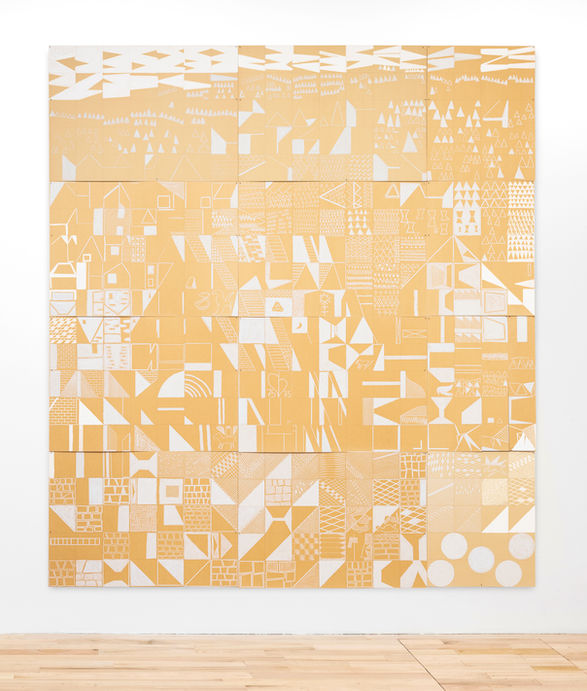PROGRESSLESSNESSLESSNESS
Proxyco. Gallery. NY.
2022.
PROXYCO Gallery is pleased to present Progresslessnesslessness, its second solo exhibition by New York-based artist Pablo Gómez Uribe.
Gómez Uribe’s previous solo show with the gallery in 2018, All That Is Solid, revolved around the conceptual model of the stress test for standardized construction materials — in particular, of bricks, architecture’s irreducible and literal building blocks. But rather than using procedural methods to measure standards of structural competency, Gómez Uribe chose to discover and display material evidence of failure and trauma. In the present exhibition he extends this line of thinking to posit the notion of a “poetic standard” for architecture — a hypothetical mode of analysis that would focus on human narratives of subjectivity and fallibility.
Upon entering the gallery, a viewer finds the exhibition’s title, Progresslessnesslessness, engraved and painted in red, letter by letter, onto 24 chunks of marble rubble, which the artist recovered from a demolition site in his native Medellín, Colombia. With its ridiculously duplicated suffixes, this made-up word — like its more legitimate lexical cousins carelessness, fearlessness, helplessness, or hopelessness — suggests the perpetuated lack of something that paradoxically continues to exert influence or pressure through its very absence.
Two other works in the gallery’s front space apply the “poetic standard” to an icon of modernist architecture — the mural Louis Kahn designed for his landmark Morton and Lenore Weiss House (1947–50), in East Norriton Township, Pennsylvania. Though Gómez Uribe already admired the architect, he was especially touched by the story of how the Weisses insisted that Kahn’s semi-abstract composition accommodate a depiction of their beloved Dalmatian. In Model for an Endless Mural (2022), Kahn’s design study is redrawn in graphite onto square wooden tiles, which are further subdivided into four squares. One tile has been removed so that the others can be rearranged to create infinite variations of the original gridded drawing, like a gameboard puzzle designed not to be solved. The second piece, A Dalmatian Affair (2022), once more adapts and revises Kahn’s mural, this time rendered with black graffiti markers onto a wall-sized installation of reclaimed white ceramic tiles. One could easily imagine this work in a subway station, authored by some very clever pseudonymous graffiti writer.
A more pointed investigation of public infrastructure unfolds in another suite of works, with a particular view to the backdrop of political and economic gridlock that now seems endemic to the COVID-19 pandemic. At the height of lockdown in 2020, while stuck home in Brooklyn, Gómez Uribe found himself tracing the Holland Tunnel on a digital map and looking at “street view” images of its interior, surprised to see so many stretches of broken or missing tiles. Researching its history, he began to associate these signs of stress and disrepair with the fate of Clifford Milburn Holland, for whom the Tunnel is named. As its remarkable chief engineer, Holland’s total commitment to the massive project drove him to a breakdown, and he died of a heart attack two days before the eastward- and westward-tunneling crews would connect beneath the Hudson River on October 29, 1924.
Gómez Uribe first establishes the Holland Tunnel’s location specs with two sets of photographic works installed on opposite walls across the gallery’s length. Eleven images printed onto tablet-like aluminum panels show pinpointed map views of the Tunnel with a corresponding inset “street view,” along with one diagrammatic map view of the whole Tunnel. The second photo work consists of 88 “street view” screencaptures, again of the Tunnel’s interior, installed like an unfinished wall of tiling. In other works, Gómez Uribe hones in on discrete sections of the Tunnel’s broken or missing tiles as though studying a wall of prehistoric petroglyphs. The gridded shapes of each excerpted Tunnel wall section are rendered in graphite, whether at full scale on muralsized sheets of tracing paper, or at reduced scale on samples of Cristanac tile coated with an institutional shade of green acrylic paint. Another work re-enacts the Tunnel’s decay with delicately drawn, exacting cuts into reclaimed white tiles.
In these various studies of our current infrastructural “progresslessnesslessness,” Gómez Uribe’s architectural “poetic standard” seems to trace coordinates within a personal nexus that moves freely between funereal homage, critical excavation, formal appreciation, and scathing indictment.
— Paul Kennedy

























